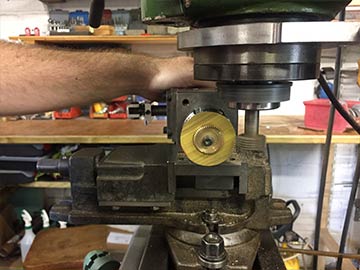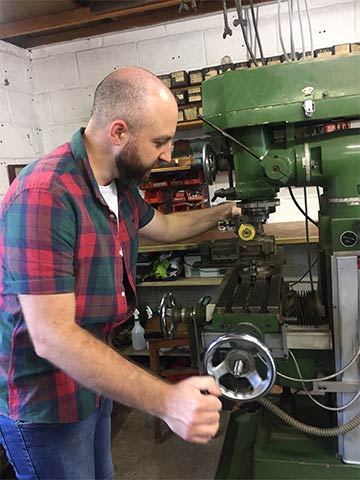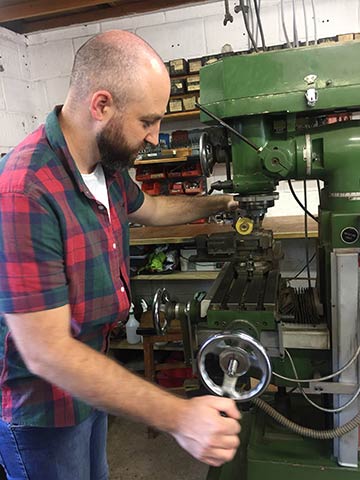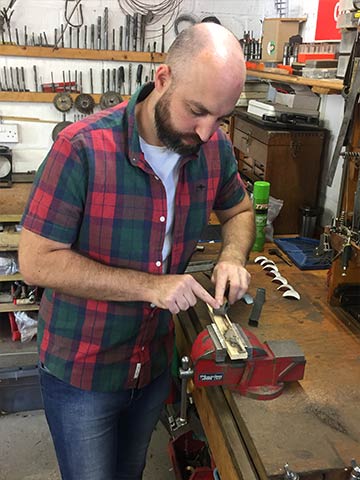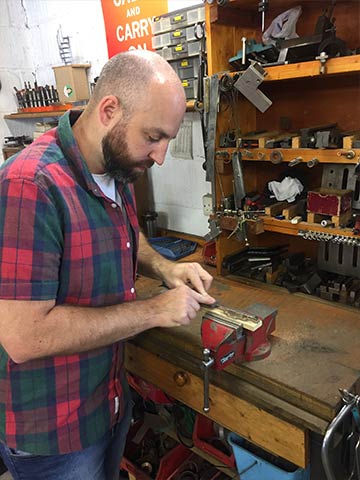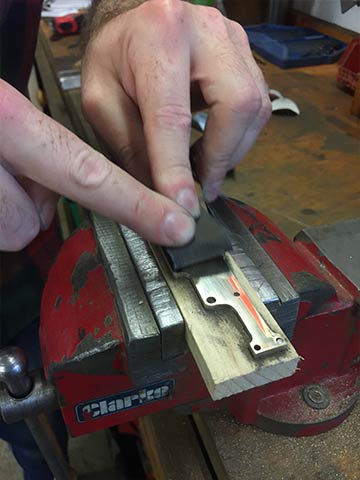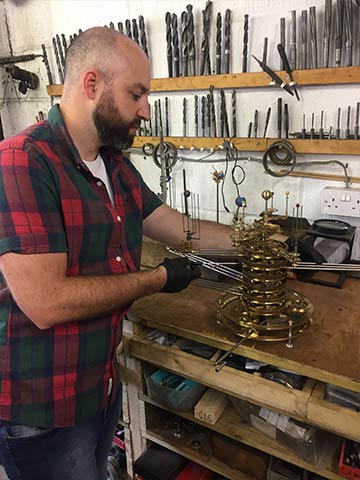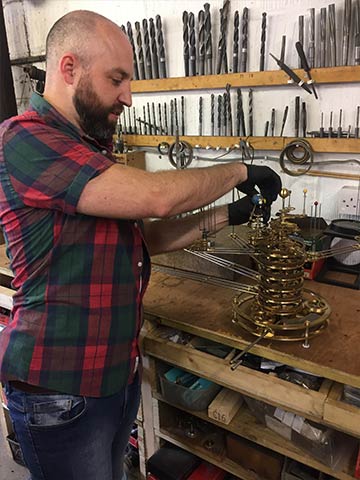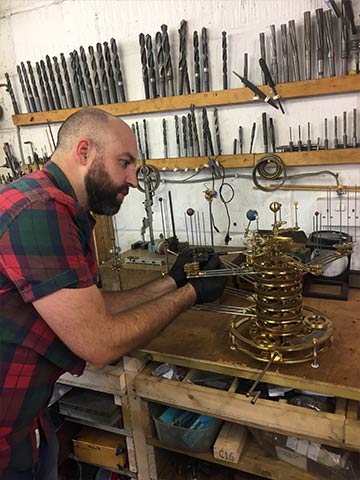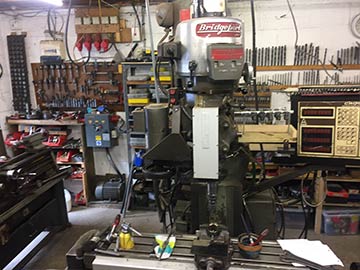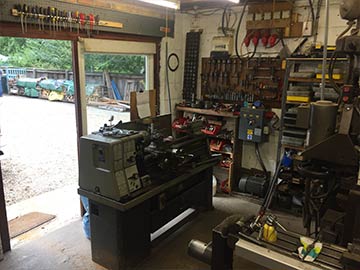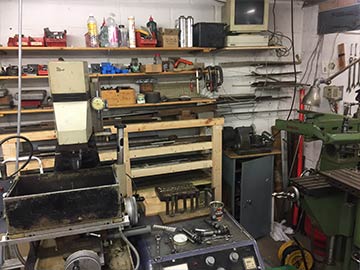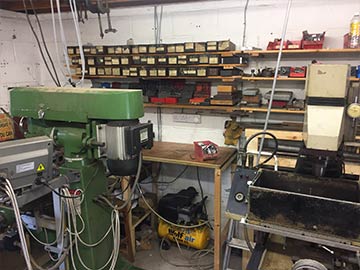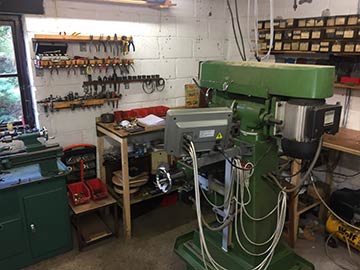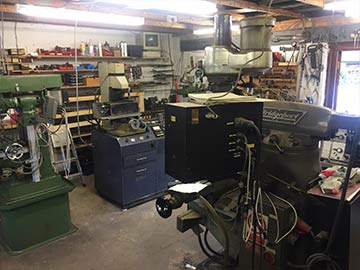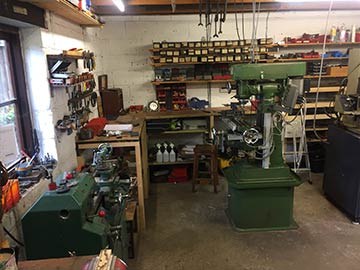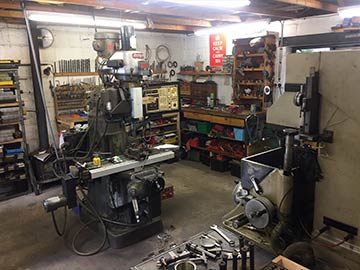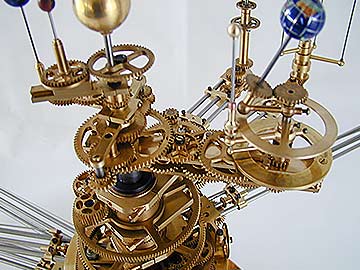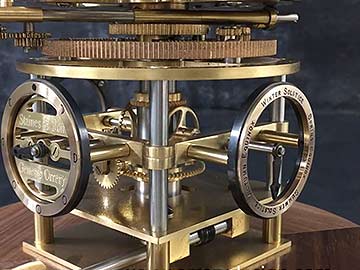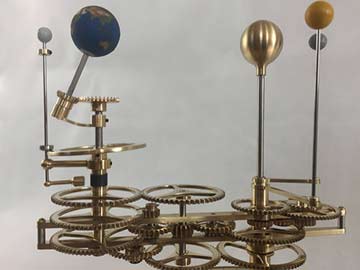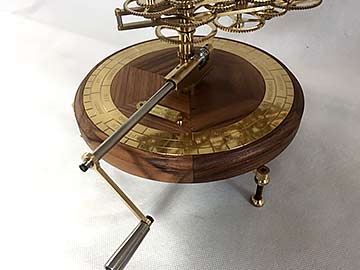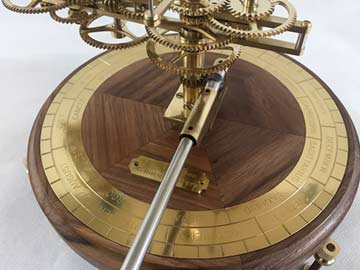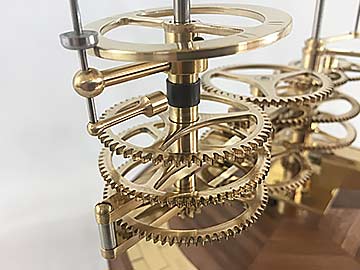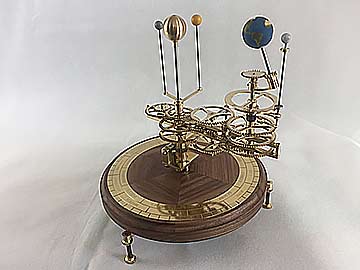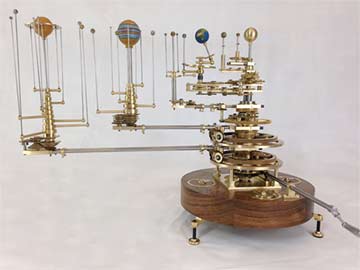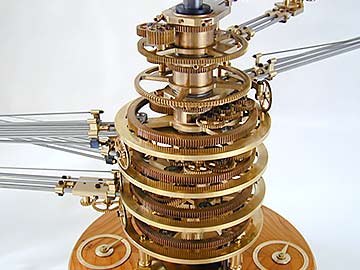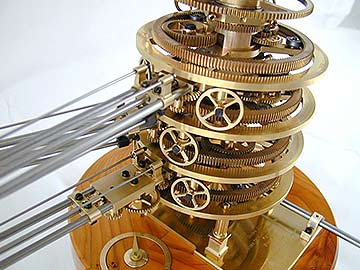Page 4


Staines and Son - Orrery Makers
By Ginger Wentrcek
1. What is an Orrery and how did you become interested in building them?
(Tim) In 1543 Nicholas Copernicus published his idea of a heliocentric solar system. This model of the solar system was later refined by Johannes Kepler. Before the beginning of the 18th century, Sir Isaac Newton eradicated all doubt of a heliocentric solar system with his Law of Universal Gravitation. We now had a definitive and irrefutable model of our solar system and the orrery was, and still is, the perfect way to demonstrate it.
(Derek)An orrery is the name generally used to describe a scientific model of the Solar System. The name comes from Sir Charles Boyle, the 4th Earl of Orrery, who in 1704 had a model solar system constructed for him by a London instrument maker. The term orrery does not refer to any particular type or design of solar model and is a general description. Over the years I have made many model steam engines as hobby, and I wanted a new challenge and to make something a little bit different. I came up with the idea of trying to reproduce the movements of part of the biggest mechanism of all - The Solar System.
2. Do you and your father have specific parts of an orrery for which you are responsible?
(Tim) Both my father and I make all or any parts required and are in constant collaboration. We both have a background in industrial engineering and have many years experience of producing precision parts.
3. What are the parts of an orrery?
(Derek)Tough question!! It really depends on how complicated, accurate, and decorative the orrery has to be. If the orrery has a wooden base, it can be made from either one piece of wood (usually walnut) or else made in sections, glued together, and then machined and polished to finish.
Apart from the base, the main component parts of a simple orrery are the centre stem upon which everything revolves, the brass frames, upon which are mounted the gear trains and the gears themselves. Additional parts are either a chapter ring, engraved with the months and zodiac, or various small dials showing the phases of the moon, solstices, and houses of the Zodiac.
A Genesis Orrery that we recently made contained about 96 gears alone, without all the other parts.
4. What is your background and training for building such an intricate and precise scientific instrument?
(Derek) I served a six year apprenticeship as a Tool and Die maker. At the age of 24, I went into partnership with my brother (a marine engineer) and for over thirty years we manufactured quality components for very demanding customers. Among the projects we designed and manufactured were tooling and components for the Harrier Jump Jet, Winscale nuclear power station, fibre optic cable tooling for the internet, and component parts for the European Air bus wing project. Tim trained at my factory and was engaged in similar work.
5. What materials do you use to build an orrery?
(Tim) The materials that we use have been selected to provide the best resistance to wear and corrosion. Most of the 'steel' components are made from stainless steel, which is not actually a steel at all, but is a non-ferrous material which provides excellent corrosion resistance. The gear frames and the gear trains are made from brass. The large worm wheel at the bottom of the orrery is made from Phospher Bronze because of its long life when used in such applications.
6. Can you describe the mathematical process you use to determine the gears you cut to make each planet rotate at the proper speed?
(Derek) The problem that we found was that the planets of the solar system do not rotate on a gear train. It is quite easy to design a gear train to rotate a planet if the planet rotates a whole number of turns without any fiddly bits left over. All the planets on the orrery rotate to within 0.1% or better of the planets actual rotations.
(Tim) A straight forward gear train ratio is a simple formula, take a clock for example. The hour hand rotates once whilst the minute hand rotates 12 times. That is a 1 to 12 ratio, which is written as 1:12. To achieve this ratio, a clockmaker could feasibly use a 10 tooth and 120 tooth gear. We apply the same formula to the planets and their moons. For example, Earth rotates once whilst the moon rotates 12.36 times. The problem is that there is no 12.36 tooth gear. We can't use the smallest 1:12.36 set, which would be 25 and 309 tooth gears, as a 309 tooth gear would be much to large. So instead, we use compound gears to progressively alter the speed of the gear train. The difficulty in designing gear trains for an orrery is bringing multiple gear trains together in a way that they remain accurate, functional, and aesthetically pleasing. The math we use becomes more complicated where epicyclic gear trains are to be used. It is really important to check your work at the design stage and then check and check again.
7. Do all the gears in your orrery work in tandem with each other or do the planetary gears work separately?
(Derek) All the planets have their own individual gear trains. The only thing connecting one set of planetary gears to another set is the drive mechanism which is taken from a centre shaft. So the answer to your question is that all the gear trains operate independently.
8. Briefly describe the planning and building process for each orrery once you receive an order.
(Derek) Good question. It is very rare that any two orreries are the same. They may be similar but it is difficult to keep in stock a supply of parts which are common. When a customer places an order, the first thing we ask is what type of base is required. Our favorite wood by far for bases is English Walnut. (Figure 1) The biggest problem with this wood is that it is very highly sought after and is very slow growing. We constantly search for Walnut for sale, and wherever we find a suitable piece, we will buy it and store it away. We were a while ago fortunate to purchase an enormous walnut plank from one of Her Majesty the Queens suppliers. He also has a stock of timber from Lord Nelson's flagship, the Victory. We are at the moment trying to “butter him up“ to sell us some. Fingers crossed.
After the base has been decided, the next question is how many planets and moons will the orrery have. (Figure 2) Once this is known, we can work out how many gears we will need to complete the orrery. (Figure 3)
Also important is the information that the customer wants the orrery to show and how this information is to be displayed. A simple brass chapter ring (Figure 1) can be engraved with the months of the year, positions of the solstices and equinox, and houses of the Zodiac. Or, the information can be read from small dials. (Figure 4)
Once all the information is at hand, we can then order in all the required materials. Then its just time and effort to complete the orrery.

Figure 1
Walnut base with simple
brass chapter ring
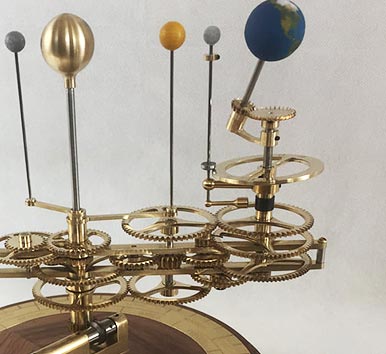
Figure 2
Mercury, Venus, Earth, Moon on Tellurion Orrery

Figure 3
Number of gears determined by number of planets and moons

Figure 4
Month, solstice/equinox position, Zodiac displayed on small dials
9. Do you remember the first orrery that you built?
(Derek) Yes, very much so because it would not work!!! I designed and built the orrery and then came the magic moment when it was complete and ready to try out. I turned the handle and the orrery smoothly turned and then stopped. I checked out the gear train and all was well, but it just would not run. I started to remove various bits and pieces and still no luck; I was absolutely stumped. In desperation, I increased the clearance between the gears that drove Earth around by about 1 thousandth of an inch, and Bingo, off it went. The gearing for Earth is so high that just gently resting a finger tip (no pressure) on Earth's spindle will bring the whole thing to a standstill.
(Tim) The first orrery that I designed was a simple nine planet orrery that had around twenty gears or so. I remember I worked out the gear train for that orrery in one evening. I was so excited to build the orrery that I set to work building it without making any technical drawings. I was in such a rush to get the gear train in place and watch the planets go around that I forgot to include perhaps the most important part of all - the drive handle. I had to post-fabricate the drive to the design.
10. What is the most elaborate orrery you have built.
(Derek) The most elaborate orrery I made was a Nine Planet Orrery with orbiting moons and the customer was based in the USA. I also make steam engines, and whilst I was talking to the customer, I mentioned that I had a steam engine for sale. I jokingly suggested that the customer should buy the steam engine to drive his new orrery. The result was the customer bought the engine and wanted it fitted to his orrery. The problem was the orrery was in the USA and the engine was in London. It all ended well - the orrery and steam engine went together perfectly. The orrery, called the Sanderson Orrery, is on YouTube and can be viewed here.
11. What is the most difficult or challenging part of building an Orrery.
(Derek) I would say the most difficult part of building an orrery is the gear trains that drive the moons. The gears absolutely HAVE to work perfectly or the moons will just not orbit. The drive for the moons is taken from a large ring gear and then transmitted to the moons on the other end of the shaft. Any misalignment and the moons just will not work. (Figure 5)
(Tim) Each orrery we make will have a set of drawing that we follow; however, we always want to improve upon our work and modify what we are doing. It is really important that we keep notes on every little change we make, no matter how insignificant it may seem at the time, otherwise we could find ourselves in a bind later on.

Figure 5
Gears that drive moons must be perfectly aligned.
12. How do you and your father collaborate in the building process.
Generally speaking we take things in turn. I might cut the gears and my father will then machine in the spokes and then finish polish them, or else I might make up the wooden base while he cuts the gears and frameworks. We really just get on and make what has to be made.
13. In what countries are your Orreries located?
(Tim) We have orreries all over the UK and across Europe in countries such as Holland, Belgium, Switzerland, Germany, France, Spain, etc. Worldwide we have sold to South Africa, Canada, China, Japan and the USA. Our biggest market is the USA, followed by the UK.
14. What makes your Orreries stand out from others?
(Derek)There are three things which I would say set us apart from other orrery manufacturers. The first is that because of our industrial background, we work to a level of precision that other makers might struggle to reach. Secondly, we have spent years designing industrial tooling and machinery which has enabled us to develop our unique orbiting moon orreries. Thirdly, it's the precision of the orbital time of the planetary arms. Also, very importantly, we like what we do and take great personal pride in our orreries.
15. What is the Heritage Crafts Association and how were you selected to become a member?
(Tim) The Heritage Craft Association was founded to help regenerate old crafts and skills that are in danger of dying out. The Association is headed by HRH Prince Charles. If you are a craftsman/woman who is involved in a rare and unusual skill, then your work may be evaluated, and depending on the type of work that you do, the quality of your work, and chances of the craft dying out, you may be offered a place on the 'endangered crafts' register. You cannot apply for this status and you probably will not know that your work has been evaluated until you are informed of it. My father and I are on the critically endangered crafts list, which means that there are very few other orrery makers who practice this ancient skill.
16. Do you have an interest in astronomy, and if so, in what activities are you able to participate?
(Tim) My father and I do not practice in any astronomy activities as such, but because of our work, we are now well versed in the workings of our solar system. For example, we can look up at the moon in the night sky and determine what moon phase we are in, which is pretty cool. We also like to keep up-to-date on the latest news, and I feel there is a lot to be excited about at the moment. Personally, I am really excited to see what new data the James Webb and ELT telescopes will bring to us in the decade to come.
Derek and Tim Staines Build a Genesis Orrery
Click a thumbnail to see a larger image or start the slideshow.
Welcome to Our Workshop
Samples of our Work


